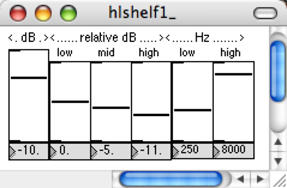Spatialisateur
Spat Introduction
|
The Source~ ModuleIntroductionThis optional module receives the input signal(s) of Spat~ and provides the two signals received by the Room~ module, which describe the virtual source:
Pre-Delay and Doppler EffectThe main role of the Source~ module is to generate a "pre-delay" in order to reproduce, if necessary, time lags existing between the signals coming from several sound sources situated at different distances from the listener. A continuous variation of this pre-delay naturally reproduces the Doppler effect (apparent pitch shift) associated to the movement of a particular source. Low-pass filtering to reproduce the effect of air absorption can also be included in Source~. At this point, the Doppler effect affects both the face signal and the omni signal. In future versions of Spat~, the behaviour of Source~ will be extented to allow pre-delay without Doppler effect -- or the reverse -- on either one of the two signals. Pre-equalization and Directivity of Sound SourcesIf necessary, the Source~ module can incorporate additional processing. For instance, a spectral correction of the face and omni signals can be included, if it is made necessary by the position of the microphone(s) relative to the instrument, or by the nature of the input signal(s). Nota Bene : From a general point of view, it is almost always necessary to apply a spectral correction to the two input signals of Room~, to account approximately for the radiation characteristics (directivity and orientation) of the virtual sound source [2, 3]. Since the directivity of a sound source is usually frequency-dependent, spectral corrections are necessary. This is why two input equalizers are already incorporated in Room~ (see below), but it can be useful, in some cases, to add a specific pre-equalization in Source~. Spectral Equalizers in Spat~All spectral corrections in Spat~ are performed with the same signal object, called hlshelf1~ . This is a "double shelving filter" which was designed specifically for Spat~, and allows to boost or cut three frequency bands separately and control the high and low transition frequencies. hlshelf1~ is made of a second-order recursive filter with a particular method of computing the coefficients, in order to achieve symmetrical boost and cut curves (on a dB scale), as well as symmetrical response curves on a log frequency scale. This control method was implemented in a Max object called coef_hlshelf1~, written by Zack Settel and included in the "jimmies" library REF#######.  The hlshelf1_ Control Interface (double shelving parametric equalizer). Note that more elaborate parametric equalizers can be built with the objects in the "jimmies" library, for instance by cascading a double shelving filter with parametric band-pass second-order equalizers. Such band-pass equalizers can be made with coef_bpass2~, which has symmetry properties similar to those described above. Spat~ 3.4 does not make use of equalizers more elaborate than the double shelving filter, so this is left up to the user. |
© CNAC-GP/Ircam and Espaces Nouveaux |